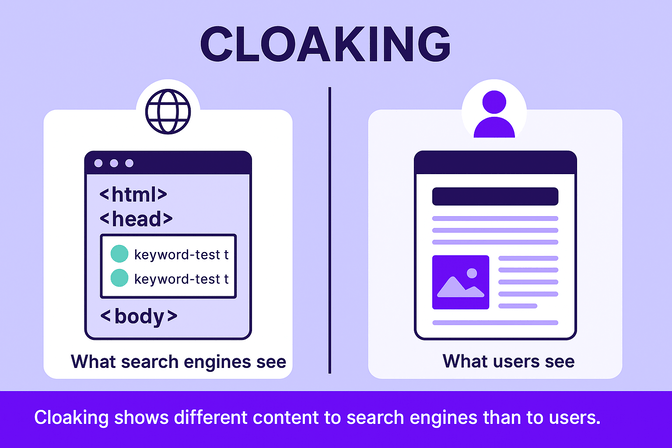One of the ways that some website owners might try and help their site perform better in search engines is through search engine optimization cloaking, or SEO cloaking. However, website cloaking is a black-hat SEO technique that violates Google’s webmaster guidelines and can lead to severe penalties.
Learn more about this outdated practice and how to safeguard your site!
What is cloaking in SEO?
Cloaking in SEO is a technique used to show different versions of your website to search engines and users. In short, it’s a deceptive tactic meant to “cheat” the search engine’s algorithm by showing the search engine the kind of content it likes to see, even if users see something totally different.
Examples of SEO cloaking

There are a few different ways someone might cloak their site. A few of the most common methods include:
- IP cloaking: Website owners might differentiate between user IP addresses and those belonging to search engine crawlers. Then, they’ll redirect or show different content accordingly.
- User-agent cloaking: This type of cloaking uses the user-agent information—browser type, operating system, and device—to serve different content to search engines.
- HTTP accept-language cloaking: People might also distinguish between search engines and users through the HTTP accept-language header, which communicates language preferences.
- Hidden text: One of the most basic forms of website cloaking is hiding on-page text from users, making it visible only to search engines. Someone might do this through JavaScript or CSS.
Why some websites use cloaking
If cloaking is so bad, you might be wondering why some websites would use it in the first place.
Common culprits include image galleries containing more visual elements than text and sites heavily dependent on JavaScript.
In short, some website owners might view it as a quick and easy fix for more profound problems. Some websites might have a bad design that’s not set up for SEO. Common culprits include image galleries containing more visual elements than text and sites heavily dependent on JavaScript.
If one of these examples describes your site, there’s no need to panic. There are ways to set these sites up for SEO success without cloaking. Google has guidelines for making JavaScript more accessible to search engines and for optimizing images.
However, the most concerning cause for cloaking is a hacked site. Even though a hacked site is out of your control, you want to take proactive measures to prevent a hacker from drawing a Google penalty against your site.
How to spot SEO cloaking

“If a site is hacked, it’s not uncommon for the hacker to use cloaking to make the hack harder for the site owner to detect.”
One of the best ways to stay proactive against cloaking penalties from a hacker is to regularly check for cloaking using a tool. Two free online cloak-checking tools are SiteChecker and DupliChecker.
Just plug your site into one of these tools occasionally (or if you notice any suspicious activity), and if you get concerning results, find the culprit so you can take immediate action.
What isn’t considered cloaking
Now that you know what cloaking is, you might wonder if some common (a-okay) tactics you’re employing on your site are cloaking. Never fear—the following practices are not cloaking when implemented correctly:
- Personalized site content
- Interactive content such as tooltips or accordions that reveal more information when clicked
- Content behind a paywall or other gate (as long as Google can access the content and you use Flexible Sampling best practices)
- Redirecting users because of a domain change or page consolidation
Redirects will only raise a red flag for cloaking if the redirected URL is substantially different from the original content.
Avoid website cloaking at all costs
In summary, all website owners should know what cloaking is so they know how to avoid it. While the temporary benefits might seem appealing, the penalties Google will dish out once they discover the cloaking can be a massive detriment to your site in the long run.
To ensure your website adheres to best practices, our expert team can help you optimize your content and avoid black-hat techniques like cloaking. Contact us online today to learn how we can enhance your SEO strategy and improve your site’s performance!
SEO Services That Aren’t Cookie Cutter
Get an SEO strategy that’s tailored for your business, industry, and revenue goals.


SEO Services That Aren’t Cookie Cutter
Get an SEO strategy that’s tailored for your business, industry, and revenue goals.
Writers

Related Resources
- What is Artificial Intelligence? 3 Key Uses for AI in SEO
- What is Black-Hat SEO? Definition, Techniques, and Why to Avoid It
- What is Bounce Rate? (And How to Improve Bounce Rate)
- What is Click-Through Rate in SEO? [A Marketer’s Guide]
- What is Domain Authority (DA)? How to Use DA to Improve Your Site
- What is Duplicate Content, and How Does It Affect Your SEO?
- What is E-E-A-T and Why is It Important for SEO?
- What is Full-Service SEO?
- What is Google Analytics?
- What is Keyword Stuffing? (And Why It’s Bad News for SEO)


